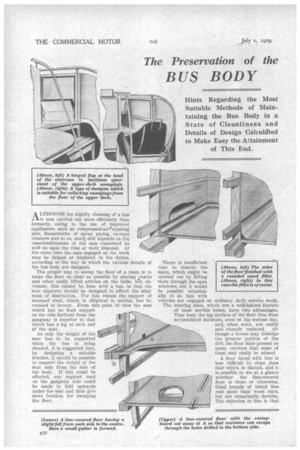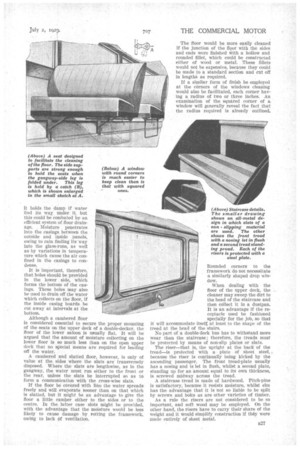The Preservation of the
Page 52

Page 53

If you've noticed an error in this article please click here to report it so we can fix it.
BUS BODY
ALTHOUGH the nightly cleaning of a bus is now carried out more efficiently than formerly, owing to the use of improved appliances, such as compressed-airrwashing Sets, frameworks of spray piping, vacuum cleaners and so on, much.1 still depends. on the conscientiousness of the men concerned as well as upon the time at their disposal. At the same time the man engaged on the work may be helped or hindered in his duties, according to the way in which the various details of the bus body are designed. The proper way to sweep the floor of a room is to make the floor as clear as possible by placing chairs and other easily lifted articles on the table, but, obviously, this cannot be clone with a. bus, so that the seat supports should be designed to afford the minimum of obstruction. For this reason the support of stamped steel, which is elliptical in section, has increased in favour. From this point of view the seat which has no floor support on the side farthest from the gangway is superior to that which has a leg at each end of the seat.
As only the weight of the seat has to be supported when the bus is being cleaned, it is suggested that, by designing a suitable bracket, it should be possible to support the weight of the seat only from the side of the body. If this . could be effected, any support used on the gangway side could be made to fold upwards under the seat and tbus give more freedom for sweeping the floor. There is insufficient time to remove the seats, which might be carried out by lifting them through the open windows, but it would be possible occasionally to do this with vehicles not engaged on ordinary daily service work. The wearing slats, which are a well-known feature
(Above, left) The sides of the floor finished with a rounded wood fillet. (Above, right) In this case the fillet is of metal.
of most service buses, have two advantages. They keep the top surface of the floor free from accumulated moisture, even on the wettest day, and, when worn, are easily and cheaply replaced.. Although a broom may dislodge the greater portion of the dirt, the floor slats present so many crevices that some of them may easily be missed.
A floor faced with lino is less difficult to clean than that which is slatted, and it is possible to see at a glance whether the lino-covered floor is dean or otherwise. GoOd brands of inlaid lino cost more than wood slats, but are remarkably durable. The objection to lino is that it holds the damp if water find its way. under it. but this could be combated byan efficient spitem of floor drainage. Moisture penetrates into the .casings between the outside and inside panels, owing to rain finding its way into the glass-runs, as well as by variations in temperature which cause the air confined in the casings to condense.
It is important, therefore, that holes should be provided in the lower side, which forms the bottom of the casings. These holes may also he used to drain off the water which collects on the floor, if the inside casing boards be cut away at intervals at the bottom.
Although a cambered floor is considered essential to secure the proper mounting of the seats on the upper deck of a double-decker, the floor of the lower saloon is usually flat. It will be argued that the amount of moisture collecting on the lower floor is so much less than on the open upper deck that no special means are required for leading off the water. • A • cambered and slatted floor, however, is only of value at the, sides where the slats are transversely disposed. Where the slats are lengthwise, as in the gangway, the water must run either to the front or the rear, unless the Oats be interrupted so as to form a communication with the cross-wise slats.
If the floor be covered with lino the water spreads freely and will evaporate sooner, than. on that which is slatted, but it might be an advantage to give the floor a little camber either to the sides or to the centre. In the latter case slots might be provided, with the advantage that the moisture would be less likely to cause damage by rotting the framework, owing to lack Of ventilation.
The floor would be more easily cleaned if the junction of the floor with the sides and ends were finished i'ith a hollow and rounded fillet, which could be constructed either of wood or metal. These fillets would not be expensive, because they could be made to a standard section and cut off in lengths as required.
If a similar form of finish be employed at the corners of the windows cleaning would also be facilitated, each corner having a radius of two or three inches. An examination of the squared corner of a window will generally reveal the fact that the radius required is already outlined.
Rounded corners to the framework do not necessitate a similarly shaped drop window.
When dealing with the floor of the upper deck, the cleaner may sweep the dirt to the head of the staircase and then collect it in a dustpan. It is an advantage if the receptacle used •be fashioned specially for the job, so that it will accommodate itself. at least to the shape of the tread at the head of the stairs.
No part of a double-deck bus has to withstand more wear than the staircase; therefore, the treads must be protected by means of non-slip plates or slats.
The riser—that is, the upright at the back of the tread—is protected with a plate of sheet steel, because the riser is continually being kicked by the ascending passenger. The front tread-plate usually has a nosing and is let in flush, whilst a second plate, standing up for an amount equal to its own thickness, is screwed midway across the tread.
A staircase tread is made of hardwood. Pitch-pine is satisfactory, because it resists moisture, whilst elm has the advantage that it is not so liable to be split by screws and bolts as are other varieties of timber.
As a rule the risers are not considered to be so important, and soft wood may be employed. On the other hand, the risers have to carry their share of the weight and it would Eimplify construction if they were made entirely of sheet metal.




















































































































